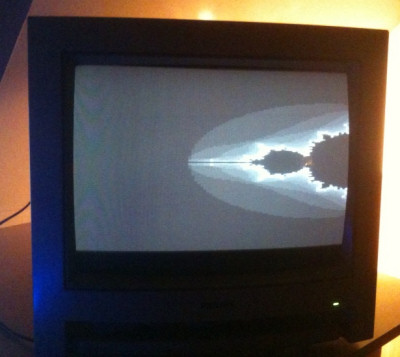Yes - just to be clear - I was going for an analogue (composite) TV signal.
Perhaps you can treat VGA as digital if you are only showing 8-colour (on/off for R,G,B). The signals would need to be 'analog' to get the different shades of red/green/blue.
If you want VGA, perhaps you want a RAMDAC, so you will have a framebuffer you can write to from the mbed board. [edit - just saw the above post, sounds like that might be a bit too hardware rather than software for you]
I was just hacking something together to see if it could be done - getting colour out of a composite signal is fiendishly complicated, so I stuck with grayscale. The DAC generates the whole signal as a single wire output.
Here's a couple of sample pics of it running on an old philips TV monitor:
drawing a fractal:

writing random values of every pixel to the framebuffer:

The on-TV pictures are generated by the mbed on the fly - I used the blank bit at the bottom of the screen to do the processing, and the rest of the time to generate the picture. Resolution is about 125x128.
You can see in this blurry pic I added 1 resistor, but other than that it is just straight into the AV input through the phono cable. It works without the resistor as well, so you can't get much more componentless than that!
Got to go, I'll have a go at publishing the code tomorrow!
I bought a mbed to play around with a video terminal replacement like the componentless VGA. I was a bit disappointed to see no real code anywhere on this project so I would have to start from scratch, I guess. Seems a shame to have to reinvent the wheel.